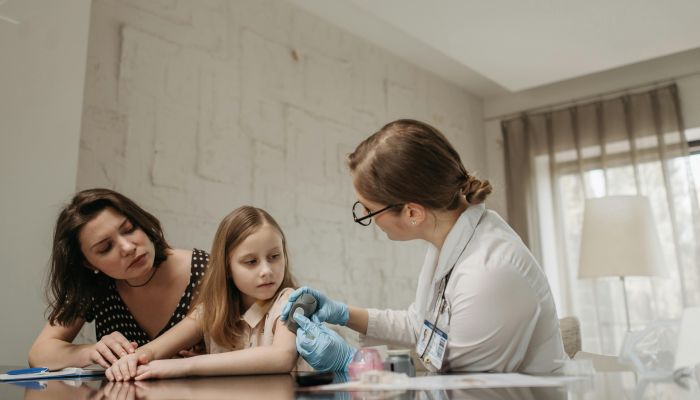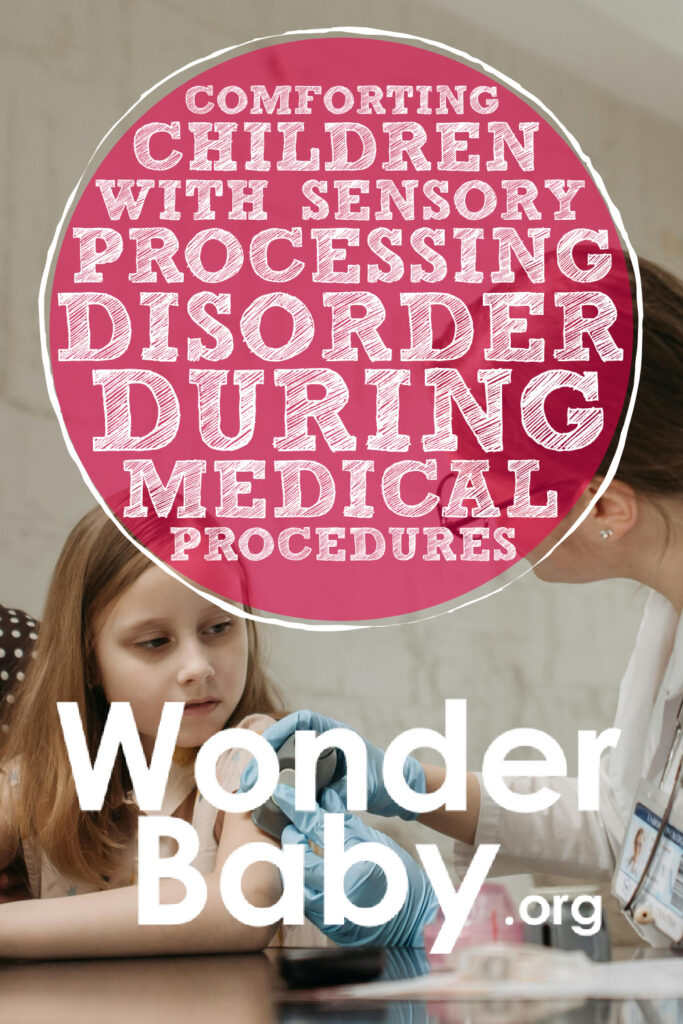Comforting Children with Sensory Processing Disorder During Medical Procedures

- Children with sensory processing disorder can successfully navigate their medical procedures using a variety of tools.
- Advanced preparation is key to learning more about the procedure and identifying specific comfort measures that will help your child during the event.
- Post-procedure support is key to helping your child process the experience and position them for future success.
Medical procedures for children can range from relatively minor tasks such as receiving immunizations to more complex procedures involving sedation and restraint.
Many children may experience some degree of difficulty during such a procedure. Children with sensory processing disorder, however, may have more challenges than their neurotypical peers.
So, how can you comfort your child with sensory processing disorder during a medical procedure?
As a parent or caregiver, there are specific things you can do before, during, and after the procedure to successfully comfort and guide a child you love through these events.
Preparing Your Child for the Medical Procedure

Generally, parents or regular caregivers are the adults who best know how to comfort their children. Their input is crucial to adequately prepare their children for the upcoming procedure.
Many parents of children with sensory processing disorder use a variety of techniques and strategies every day to successfully navigate a wide range of situations.
The question becomes how to successfully adapt those comfort measures to a medical situation.
Gathering Information
When you learn that your child needs a medical procedure, it’s a smart idea to learn as much as you can about that test ahead of time.
Your child’s healthcare provider can describe the test or procedure during your appointment or help you find reliable sources to answer your questions.
Often, they will also be aware of the finer points of the task, such as whether or not parents or caregivers are allowed to stay with their child during the procedure.
Other professionals involved in your child’s care, such as a pediatric physical therapist or occupational therapist, may also have insight into how to guide your child through the event.
Creating a Comfort Plan
A comfort plan can be as simple as asking to hold your child11. Comfort Positioning During Procedures. Children’s Hospital of Philadelphia. https://www.chop.edu/centers-programs/child-life-education-and-creative-arts-therapy/prepare-your-child-visit-doctor/comfort-positioning-during-procedures during immunizations or a more structured comfort and coping care plan22. Procedural Services: Coping & Comfort Plan. Luriechildrens.org. https://www.luriechildrens.org/globalassets/media/pages/appointments/surgery-prep_child-life_comfort-plan_05-2023.pdf.
It’s a good idea to ask to talk to the manager, staff members, or a designated care coordinator at the medical facility before the procedure to jointly establish a care plan for your child.
There’s nothing more frustrating than showing up with a carefully constructed plan for your child and learning that all or some of the key points can’t be accommodated.
Ask that identified accommodations be entered in your child’s medical record before the procedure to avoid miscommunications on the actual day and allow staff to make their best preparations to receive your child.
Pre-Visit Preparation
There are specific steps you can take to help comfort your child in the days leading up to your child’s medical procedure.
Consider activities such as:
- Intentional big-body movement. It’s normal for all children to have some big feelings leading up to a medical procedure. Creating space to engage in big body movements like running, swinging, or playing on a playground gives physical release to pre-procedure jitters and may position your sensory-seeker to healthily process their emotions.
- Medical play. Using a simple toy medical kit, engage in some structured play with your child. This can be a great way to rehearse elements of the upcoming medical procedure. Use a favorite lovey or take turns practicing on each other to let children learn the sensation of listening with a stethoscope or looking in their ears.
- Realistic Play Experience: Toddlers will hear the heartbeat when press the stethoscope toy; the blood pressure cuff works like a real one, while the flashlight, thermometer, and otoscope emit light during play. The pressable syringe adds to the interactive and engaging experience for children
- Educational and Therapeutic: Our doctor toys can help alleviate children’s fear of medical procedures and visiting doctors. Encourages imaginative pretend play and healthy habits for preschool kids ages 3-6 years
- Portable Medical Bag:The doctor bag is big enough to hold all of the doctor playset pieces. It not only keeps things organized at home but also makes it convenient for travel
- Child-friendly Design: Each tool in doctor playset is designed with little hands in mind, ensuring easy grasping and safe play. There are no sharp edges or objects to worry about
- Talk with your child. Answer your child’s questions factually and in simple terms, If you don’t know an answer, offer to look into it together or simply say, “I don’t know.” The Children’s Hospital of Philadelphia33. Truth telling: Why honesty is the best policy. Children’s Hospital of Philadelphia. https://www.chop.edu/centers-programs/cardiac-center/truth-telling-why-honesty-best-policy#:~:text=When%20it%20comes%20to%20supporting,what%20is%20happening%20and%20why. encourages parents to be honest with their children as they support them through medical testing and procedures. Though parents may feel awkward or have their own worries about having these conversations with their children, it’s been discovered that children may lose trust in their parents or caregivers, medical professionals, and the future of their healthcare when they fail to receive reliable information from someone they trust.
What to Do During the Medical Procedure

Ready or not, the day of your child’s procedure has arrived.
Consider the following suggestions to help them comfort your child and position them for success during the task ahead.
Communication
Encourage your child to advocate for themselves as they work with medical professionals to get ready for their procedure. It’s OK for children to say, “I’m scared” or, “Can I use this tool?” to alert the staff around them to their needs.
If your child isn’t able or willing to communicate their needs in this situation, you as their parent will need to be that voice for them. Advocating for your child in a polite, respectful tone helps staff know what your child needs and positions them to work with you to best help your child.
Sensory Accommodations
Many children, whether or not they have sensory processing challenges, may have trouble navigating a public space or medical environment.
Sensory accommodations can often be incorporated into a medical environment to help comfort a child.
Consider some of the following ideas:
- Weighted blankets or vests (Extra blankets can also be used if weighted items are unavailable.)
- Using a favorite blanket from home to line a stretcher or procedure table.
- Sunglasses or visors to dim overhead lights
- Fidget toys
- Chewing on straws or chewable jewelry to provide oral input
- Noise-canceling or reducing headphones
If your child has conditions that necessitate frequent interaction with a medical environment, it’s a good idea to have sensory tools that live in your car to help your child successfully navigate unexpected medical situations.
Distraction Techniques
Child life therapists are specially trained professionals who help children with a variety of medical conditions successfully navigate medical procedures and hospital experience through play.
While a medical facility may or may not have these individuals available to work with your child before or during their specific procedure, you can use some of their techniques to help distract your child from focusing on different bodily sensations during the event.
Common distraction techniques during medical procedures include:
- Singing
- Counting
- Blowing bubbles or pinwheels
- Listening to nature sounds or favorite music
- Tapping or using a bumblebee device44. How to use BUZZY in healthcare settings. The Royal Children’s Hospital Melbourne. https://www.rch.org.au/uploadedFiles/Main/Content/comfortkids/BUZZYR Presentation in PDF .pdf during injections or IV starts
- Mindfulness or grounding exercises55. Grounding: A calming exercise for children and teenagers. Raising Children Network. 2023. https://raisingchildren.net.au/guides/activity-guides/wellbeing/grounding-calming-exercise-children-teenagers
- Guided imagery66. Guided Imagery. Children’s Hospital of Orange County. https://choc.org/programs-services/integrative-health/guided-imagery/
- Watching favorite TV shows or movies
Although you may not be able to fully distract your child from what’s happening to them during the procedure, the hope is to reduce their fear or anxiety to a manageable point that allows them to successfully move through the event.
Positive Reinforcement
While this technique may feel like bribery, it actually has its roots in psychology and behavior modification.
Experts at the University of Central Florida77. Reinforcement and punishment. General Psychology: University of Central Florida. https://pressbooks.online.ucf.edu/lumenpsychology/chapter/operant-conditioning/#:~:text=Positive%20reinforcement%20is%20a%20process,by%20removing%20an%20undesirable%20consequence. remind us that children who experience positive reinforcement are more likely to continue the desired behavior than those who experience negative consequences for behavior.
The reward doesn’t have to be expensive or extravagant to be meaningful.
As an example, I’ve used this technique successfully with my own children:
One of my children struggled with wearing a mask during medical appointments a few years ago. A member of my child’s healthcare team suggested bringing a pack of football cards (their preferred reward) along to appointments where masks would be worn
Every 3–5 minutes they kept on the mask without fussing or taking it off, I would hand them a card. If they took their mask off during that time interval, they wouldn’t receive a card and could make a different choice for the next period.
Receiving the positive reinforcement of a desired object gradually shifted the focus from mask irritability to receiving a reward, which reduced the tension considerably for all of us.
After the Medical Procedure

After your child’s procedure, it’s often wise to let them have a day or two to process the event before initiating a conversation about the event. Ask your child what they thought went well, what didn’t, and their input on what might work better next time.
I’ve often been surprised by insights my children have offered after medical procedures and have used their suggestions to make positive changes for future events.
In the days after your child’s medical procedure, it’s also a good idea to circle back with the manager, staff members, or designated care coordinator you spoke with before their appointment. Offer feedback (positive and negative) regarding your child’s experience to help the facility sustain, modify, or create new policies to best care for children and their families.
It can be difficult for parents to know how to comfort their children during medical procedures, particularly when their children have sensory challenges. By learning how to help your child prepare for the event, move through the experience, and process the aftermath, you can help your child with sensory processing challenges learn skills that will help them successfully endure medical procedures in the future.
References
- Comfort Positioning During Procedures. Children’s Hospital of Philadelphia. (n.d.). https://www.chop.edu/centers-programs/child-life-education-and-creative-arts-therapy/prepare-your-child-visit-doctor/comfort-positioning-during-procedures
- Procedural Services: Coping & Comfort Plan. Luriechildrens.org. (n.d.). https://www.luriechildrens.org/globalassets/media/pages/appointments/surgery-prep_child-life_comfort-plan_05-2023.pdf
- Truth telling: Why honesty is the best policy. Children’s Hospital of Philadelphia. (n.d.). https://www.chop.edu/centers-programs/cardiac-center/truth-telling-why-honesty-best-policy#:~:text=When%20it%20comes%20to%20supporting,what%20is%20happening%20and%20why.
- How to use BUZZY in healthcare settings. The Royal Children’s Hospital Melbourne. (n.d.). https://www.rch.org.au/uploadedFiles/Main/Content/comfortkids/BUZZYR Presentation in PDF .pdf
- Grounding: A calming exercise for children and teenagers. Raising Children Network. (2023, June 15). https://raisingchildren.net.au/guides/activity-guides/wellbeing/grounding-calming-exercise-children-teenagers
- Guided Imagery. Children’s Hospital of Orange County. (n.d.). https://choc.org/programs-services/integrative-health/guided-imagery/
- Reinforcement and punishment. General Psychology: University of Central Florida. (n.d.). https://pressbooks.online.ucf.edu/lumenpsychology/chapter/operant-conditioning/#:~:text=Positive%20reinforcement%20is%20a%20process,by%20removing%20an%20undesirable%20consequence.

The information WonderBaby provides is not intended to be, and does not constitute, medical or other health advice or diagnosis and should not be used as such. Always consult with a qualified medical professional about your specific circumstances.
Related Posts

Eye Conditions and Syndromes, Visual Impairment
Neuralink Announces Plans to Restore Sight to the Blind with Brain Chip
Elon Musk’s company Neuralink has announced plans to begin human trials of its new “Blindsight” brain chip by the end of 2025.

Special Needs
5 Spring Cleaning Tips for Families of Children with Disabilities
Spring cleaning is an opportunity to create a more accessible, organized, and supportive space for your child with disabilities. Declutter, deep clean, and refresh!

Visual Impairment
The Gift of Understanding: How a Young Child Helps His Blind Father Navigate Life
When a parent is blind, it’s natural for people to wonder how their sighted child will adapt. Will they struggle to understand their parent’s needs? Will they feel burdened by...
